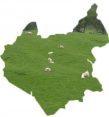1818 (population of Sproxton 310 in 1811)
There was a day school with 20 children, some of whom were supported by their parents, but the parish paid £10 per annum to the schoolmaster ‘for teaching the poorest of the children’. The school had been built in 1800 and had capacity for 60 children.
1833 (population 378 in 1831)
There were four daily schools in 1833, teaching a total of 47 boys and 22 girls. The parish contributed £10 annually for the instruction of 16 of these children, with the parents of the other children covering the cost.
Anglican schools in 1847
One day school was recorded for Sproxton and Saltby, attended by 15 boys and 6 girls. The master was paid £38, but it was said that this was likely to be reduced to £33. The total cost of running the school was said to be £50 annually, covered by subscriptions and payments by the children’s parents.
From 1870
A National School was built in 1871 at a cost of £600, with £250 of that sum donated by the Duke of Rutland and the remainder raised locally. The Duke also provided a house for a teacher and gave £10 annually towards the teacher’s salary. The school was to serve the two villages of Sproxton and Saltby. There were 120 children who attended in 1877, but numbers dropped towards the end of the 19th and into the 20th century. Average attendance was 72 in 1895, and just 51 in 1908.
Sunday schools
There was a Sunday school in 1818, whose teachers were volunteers; it was attended by about 70 children. Under the will of Joseph Kirkby, who died in 1829, the interest on a net legacy of £36 was paid to the vicar for the use and benefit of this Anglican Sunday school. In 1833, the Sunday school was attended by 47 boys and 30 girls and was supported by a combination of Kirkby’s legacy, an annual donation of 2 guineas from the Duke of Rutland and from collections after occasional sermons at the church. In 1847, 24 boys and 32 girls attended. No details are available for attendance in 1851, but by then there was also a Wesleyan Sunday school in Sproxton, which met in the morning, and had an average weekly attendance of 30.
Sources
- Education of the Poor Digest, Parl. Papers 1819 (224)
- Education Enquiry, Parl. Papers 1835 (62)
- Charity Enquiry, Parl. Papers 1839 [163]
- National Society for Promoting the Education of the Poor in the Principles of the Established Church, Result of the Returns to the General Inquiry made by the National Society, into the state and progress of schools for the education of the poor … during the years 1846-7, throughout England and Wales (London, 1849).
- 1851 Ecclesiastical census
- Trade directories
- Grantham Journal
